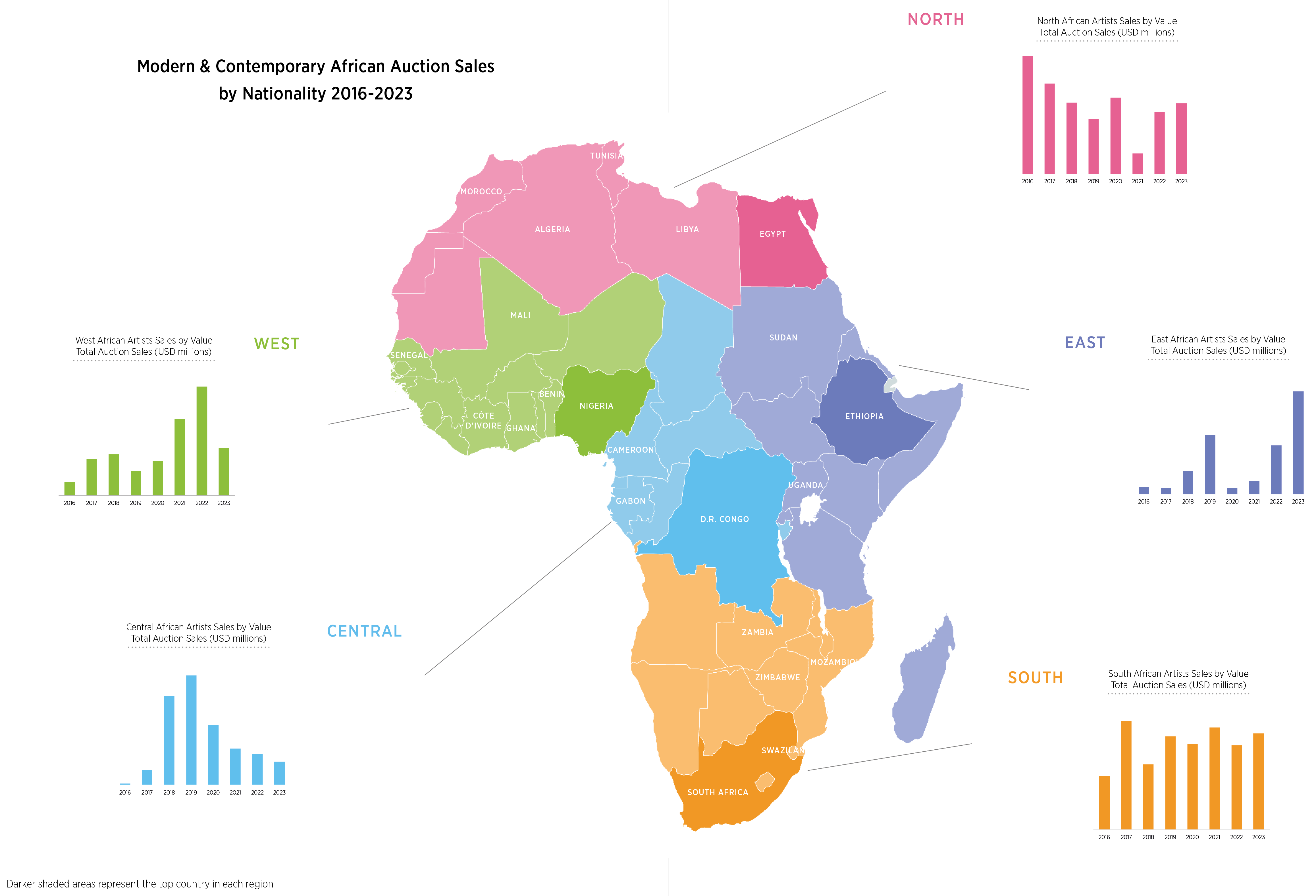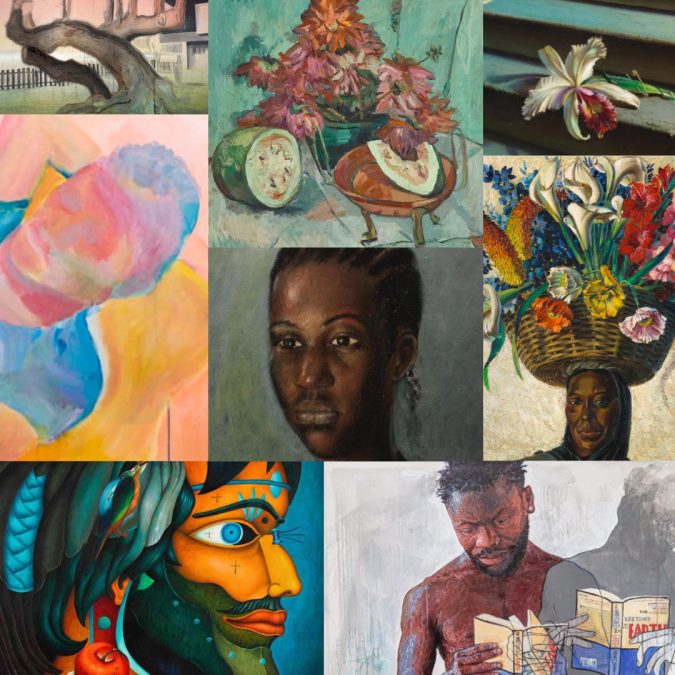Expert Insights Amid This Year’s Economic Uncertainties
Following the release of the Modern & Contemporary African Artist Market Report 2016-2023, ArtTactic engaged with key stakeholders in the African art ecosystem to gain deeper insights into this dynamic segment of the global art market. Our report revealed that the African segment only experienced a modest decline of 8.4% in 2023, contrasting with the broader modern & contemporary market, which saw nearly an 18% decrease during the same period. Since ArtTactic began its analysis of this sector in 2016, the African art market has undergone dynamic transformations driven by collectors evolving tastes, heightened global awareness, and the emergence of new opportunities. Other key market drivers included increased institutional attention towards African-born artists in recent years and the emergence of renowned artists, such as Marlene Dumas, Julie Mehretu, and El Anatsui, as top sellers both in this sector and the art market on the whole. Through a series of interviews with five key market experts, ArtTactic cultivated a nuanced understanding of the prevailing sentiments among different stakeholders in the Modern & Contemporary African art market, adding further context to our recently released report.
We began with insights from Alastair Meredith, Head of Department & Auctioneer at Strauss and Co., who reflected on the dynamic nature of the market today, noting, “while demand for quality Contemporary African art remains robust, there is a noticeable and growing interest in the moderns.” Danda Jaroljmek, Director at the Circle Art Agency Kenya, then highlighted the market’s global visibility, observing that, “we’re witnessing the emergence of more online platforms that extend visibility into markets previously untapped.” Next, Jo Stella-Sawicka, Senior Director at Goodman Gallery, celebrated the international recognition of African artists in her response, stating that, “there’s been a notable focus from international institutions on artists from or connected to the continent.” Furthermore, Hannah O’Leary, Senior Director in Modern & Contemporary African Art at Sotheby’s, shed light on the impact of socio-political movements, asserting that, “since mid-2020, we’ve witnessed a surge of interest in African and Diaspora art following George Floyd’s tragic death and the resurgence of the Black Lives Matter movement.” Lastly, Kéwé Lô, Director at Black Rock Sénégal, offered a unique perspective rooted in community engagement, sharing that, “Black Rock serves as a sanctuary for artists, providing them with a platform to be heard, supported, and respected in their creative endeavours.”
Together, all five African art market specialists provided a diverse range of perspectives on the recent developments, challenges, and opportunities shaping the African art market in 2024.
NAVIGATING MARKET SHIFTS AND TRENDS
“Tracing an artist’s lineage – whether stylistic or conceptual – has become a rewarding priority for many collectors.”
-ALASTAIR MEREDITH, STRAUSS & CO.
During our interview, Meredith illuminated a significant shift towards a deeper appreciation of historical context within contemporary art collections. He noted, “Collectors are increasingly contextualizing their contemporary holdings by integrating relevant artists from earlier generations.” Jaroljmek echoed this sentiment, emphasizing the rising interest in African artists due to the expanding opportunities for exposure through various digital platforms. Similarly, O’Leary called attention to the surge of interest in African and Diaspora art following more recent significant global events, which has resulted in a sustained growth trajectory.
On another note, Stella-Sawicka underscored the regional nuances and specificities within the African art landscape. She cited Cape Town’s emergence as an international art hub and the heightened focus on African artists by international institutions. Lô also emphasized the importance of nurturing local artistic communities and providing platforms for experimentation and dialogue. Ultimately, all five experts agreed that the trajectory of the African art market is undergoing a profound transformation and playing close attention to navigating these market shifts and trends will prove vital in serving both the artists and their growing global audience.
CONFRONTING CHALLENGES
Amidst a period of remarkable growth, the African art market grapples with a myriad of challenges, from logistical hurdles to infrastructure deficiencies. Meredith underscored the imperative of building robust networks across diverse regional markets, acknowledging the complexities involved. Jaroljmek further highlighted the absence of government support and corporate patronage within the Kenyan art ecosystem, underscoring the need for systemic changes to foster growth. Lô’s insights illuminated the intersection of environmental and social concerns, emphasizing the art residency’s commitment to community engagement and sustainability. O’Leary then stressed the importance of investing in education and infrastructure for sustained growth, recognizing the foundational work needed in emerging markets. Stella-Sawicka amplified this sentiment, drawing attention to the disproportionate impact of climate change on vulnerable communities in the Global South and advocating for sustainable practices within the art industry.
“A big challenge that is not often discussed in the context of the art market is the disproportionate impact of climate change on the Global South. Important initiatives to address the art world’s response to the climate crisis that have come from the global north, such as Climate Coalition, speak to a context that does not translate meaningfully to the infrastructure, shipping, transport and material realities faced on the continent.”
– JO STELLA-SAWICKA, Goodman gallery
Yet, despite these challenges, there’s an undeniable sense of optimism and determination among experts to navigate and overcome the obstacles facing the African art ecosystem. Through collaboration, innovation, and a commitment to sustainable development, the African art market stands poised to realize its full potential on the global stage.
EMBRACING NEW OPPORTUNITIES
In the dynamic landscape of the African art market, challenges intertwine with an array of opportunities waiting to be seized. Lô’s visionary perspective accentuates the transformative impact of community engagement and creative exploration, envisioning a future marked by vibrant growth and enriching cultural exchange. O’Leary champions the untapped potential inherent in the African market, advocating for greater representation of African artists within esteemed museums and collections.
“We see such huge potential for growth in this market. By 2050, one in every four people on the planet will be African – yet African artists represents just 0.9%* of contemporary art sales value today. Our focus has always been on collectors on the continent itself, who account for approximately two-thirds of our buyers in Sotheby’s African auctions.”
– hannah o’leary, sOTHEBY’S
Stella-Sawicka then underscores the significance of nurturing connections across the Global South to foster dialogue and solidarity among diverse artistic communities. Meanwhile, Meredith identifies education as a pivotal catalyst for market expansion, emphasizing, “Education is perhaps the key driver of a burgeoning market.” Jaroljmek looks towards collaboration and the expansion of exhibition spaces as pathways to growth, asserting, “We need to persuade the big art fairs to accept African galleries.”
LOOKING AHEAD IN 2024
Despite the prevailing economic climate, the outlook for the African art market remains positive. Meredith projects a trajectory of steady growth, underpinned by the dynamic contemporary scene, affirming, “The outlook is undeniably promising.” Jaroljmek echoes this sentiment, noting a shift towards more strategic collecting practices amidst prevailing global uncertainties.
“The market for art worldwide is more cautious, and the African art market is no different. Collectors are closing more carefully, so I would expect that we will see less risk taking with collectors acquiring more established artists.”
– danda jaroljmek, circle agency kenya
Looking ahead, O’Leary anticipates a significant uptick in institutional recognition for African modernism in 2024 through prominent museum exhibitions, signaling a widening acknowledgment of historical artists. Stella-Sawicka also underscores the criticality of fostering cross-cultural partnerships and community engagement as essential drivers of resilience and market expansion.

As collectors and industry players eagerly await the upcoming Modern & Contemporary African Art auctions this week, the African art market braces for its inaugural challenge of 2024. The London sales kick off at Sotheby’s on 21 March, followed by Bonhams on 27 March. In Cape Town, Strauss & Co hosted their Evening Sale on 19 March, having previously brought their first selling exhibition for South African artist Alexis Preller to London from 5-10 March. Further details are available here.
The African art market stands as a true testament to the intersection of commerce and culture, positioned to play a pivotal role in reshaping the importance of artists from the Global South in the evolving art landscape. With strategic planning, collaborative initiatives, and dedicated talent development, the market offers both cultural enrichment and economic advancement for future generations.
Learn more by downloading our Modern & Contemporary African Artist Market Report 2016-2023 now available online.
*Based on the total auction sales data from ArtTactic’s Global Art Market Outlook 2024 Report.
_________________________________
Are you a student or recent graduate eager to contribute your voice to ArtTactic’s Editorial vision? We’d love to hear from you!
Reach out to Brooke Reese (brooke@arttactic.com) for more information.

